

How to start growing mushrooms at home - ABC Everyday. A windowless garage might not sound like the best spot to grow food, yet Joel Orchard is doing just that.
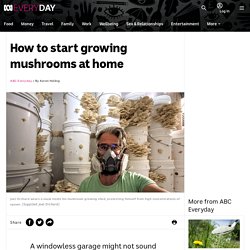
Out the back of his Lismore rental, in northern New South Wales, Joel and his sister Chez are "vertically farming" inside their shed — growing enough nutritious oyster mushrooms in stacked buckets to feed both themselves and their local community. It was a hobby born out of the COVID-19 pandemic, which grew into a small local food business. Each bucket yields about a month's supply of mushrooms for a small family, Joel says. He believes almost anyone can grow their own mushrooms in reusable buckets — even folks with limited space or no room at all for a veggie patch. Shipping container farm teaching TAFE students more than just agriculture.
Nestled beside a building on a TAFE campus in Toowoomba is an ugly metal shipping container, but it's no ordinary storage shed.
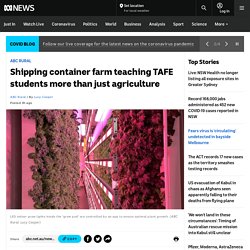
Step inside and it's bursting with greenery. Packed floor to ceiling with vegetables and herbs like basil, kale, mint and mustard, this state-of-the-art modular farm is changing the future of agriculture, all with the push of a button. Novel plant design for agrivoltaics. Developed by Chinese researchers, the novel design methodology consists of utilizing metal brackets as mounting structures, conventional solar panels, and a grooved glass plate placed between the solar panels.
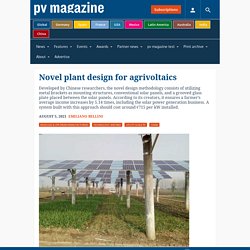
According to its creators, it ensures a farmer’s average income increases by 5.14 times, including the solar power generation business. A system built with this approach should cost around €715 per kW installed. Hydroponic Gardens: The Lettuce Raft Method. If you are interested in putting together your own hydroponic garden at home and want to start with a simple, foolproof method, a “lettuce raft” (also known as "deep water culture") system might be perfect for you.

This method allows you to grow an abundance of small, lightweight crops such as lettuce, spinach, endives, or herbs such as basil, parsley, and cilantro. The concept behind this setup is simple: plants are grown on a “raft” made of rigid Styrofoam floating in a pool of nutrient-rich water. A lettuce raft consists of three major parts: Reservoir. The shipping container farm that's the way of the future. Recycled shipping containers have been used for many things in their second life, from swimming pools and restaurants to classrooms and emergency hospitals.
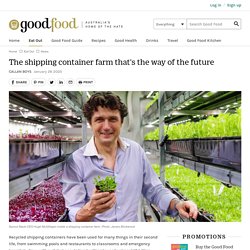
Now, with a global population hurtling towards almost 10 billion people by 2050, they may also be the farms of the future. Founded by Francisco Caffarena and Michael Harder in 2016, Sprout Stack is Australia's only commercial vertical farm. The Brookvale-based start-up utilises shipping containers to grow greens for independent grocers using methods more productive than traditional farming, says chief executive Hugh McGilligan.
"Vertical farming is also called controlled environment agriculture," he says. "Lighting in the containers is designed to optimise plant growth in vertical stacks, and we have sensors constantly measuring temperature, humidity and carbon dioxide levels which can be adjusted as needed. Australia’s first fully automated vertical farm completes R&D phase. After four years of research and development, Stacked Farm, the country’s first end-to-end automated indoor vertical farm, is about to deliver leafy greens and herbs to national wholesalers including Sumo Salad, QSR and Morco Fresh – supplying fresh produce to casinos, inflight airline catering and retail outlets.
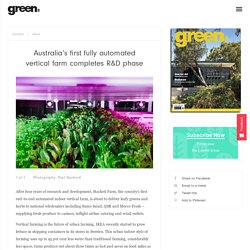
Vertical farming is the future of urban farming. IKEA recently started to grow lettuce in shipping containers in its stores in Sweden. This urban indoor style of farming uses up to 95 per cent less water than traditional farming, considerably less space, turns produce out about three times as fast and saves on food miles as produce can go from farm to plate in as little as an hour.
Vertical Farm Systems. Wow, what a ride!
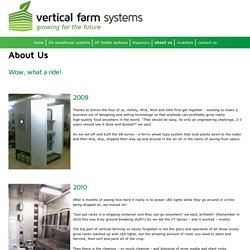
Thanks to Simon the four of us, Ashley, Mick, Nick and John first get together - wanting to make a business out of designing and selling technology so that anybody can profitably grow really high-quality food anywhere in the world. “That should be easy, its only an engineering challenge, 2-3 years should see it done and dusted!!” Modular Farms Australia - JADE Engineering. Jade Engineering assisted Modular Farms throughout the design and construction of their modules.
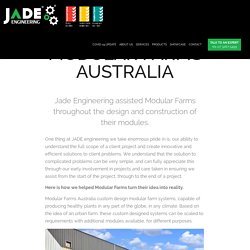
One thing at JADE engineering we take enormous pride in is, our ability to understand the full scope of a client project and create innovative and efficient solutions to client problems. We understand that the solution to complicated problems can be very simple, and can fully appreciate this through our early involvement in projects and care taken in ensuring we assist from the start of the project, through to the end of a project. Here is how we helped Modular Farms turn their idea into reality. Modular Farms Australia custom design modular farm systems, capable of producing healthy plants in any part of the globe, in any climate. A Look at Geoponic Technology for Vertical Farming. You’ve probably heard people talk about how vertical farms and their space-saving approaches to agriculture could help promote future food security and bring produce closer to those who consume it.
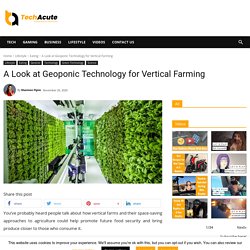
Many of today’s currently operating or planned vertical farms use hydroponic methods to grow the plants in water or aeroponic techniques where growers suspend the plants in the air and mist them. However, some vertical farms also use geoponic technology. It involves growing plants within soil or an aggregate, which is probably the most familiar option to people who are not agriculture professionals. Here’s a glimpse at what’s possible when agricultural companies combine vertical farming with the latest options in geoponic technology.
Purpose Built Container Farms. The shipping container farm that's the way of the future. Indoor Farms Constructed Using Shipping Containers. Indoor farms have become one of the latest trends to be gripped by the craze of transforming the humble shipping container for a brand new purpose other than transportation or storage.
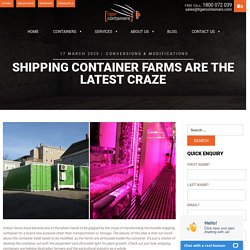
The beauty of this idea is that not much about the container itself needs to be modified, as the farms are all housed inside the container. It’s just a matter of decking the container out with the equipment and ultraviolet light for plant growth. Check out just how shipping containers are helping Australian farmers and the agricultural industry as a whole. We have seen shipping containers repurposed into a number of things over the years from luxury homes to chic cafes and restaurants. And just when you thought nothing else can be made from shipping containers, people come up with something new and more audacious. Shipping Containers To Buy or Hire.
Shipping containers have a variety of uses ranging from granny flats and offices, to storage and this will affect the price. The price is also dependent on other factors such as delivery costs and the container’s condition (i.e. either new or used). Planning permission refers to the formal permission given from local authorities to build or modify structures and is generally given as a building permit.
Shipping containers are considered temporary structures and as such do not legally require a building permit. If however, the container is going to be situated in a dense residential area, then checking with local authorities is advised. While Tiger Containers do not formally make houses from shipping containers, we do modify them into granny flats, student retreats etc. Ultimate Guide to Shipping Container Farms - Discover Containers. Ultimate Guide to Shipping Container Farms Updated On: April 8, 2021 Interested in Container Homes?
You need our FREE cheat sheets to help decide if containers are right for you! Shipping Container setup for Aquaponics combining Fish Aquaculture wit – Ingenious Outdoor Storage Inc. Ready to go shipping container with installed aquaponics, system combines fish aquaculture with hydroponics, cultivating plants in water under artificial lighting. A shipping container is a fast solution and easily expandable by simply adding more containers. A shipping container is ready to use on delivery and delivery can be effected in a day or two. You just need to add shelves and install power.